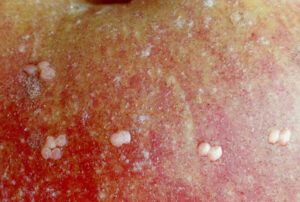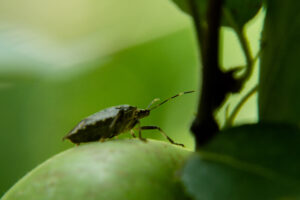WNC Orchard Insect Pest Populations – July 20, 2021
go.ncsu.edu/readext?810038
en Español / em Português
El inglés es el idioma de control de esta página. En la medida en que haya algún conflicto entre la traducción al inglés y la traducción, el inglés prevalece.
Al hacer clic en el enlace de traducción se activa un servicio de traducción gratuito para convertir la página al español. Al igual que con cualquier traducción por Internet, la conversión no es sensible al contexto y puede que no traduzca el texto en su significado original. NC State Extension no garantiza la exactitud del texto traducido. Por favor, tenga en cuenta que algunas aplicaciones y/o servicios pueden no funcionar como se espera cuando se traducen.
Português
Inglês é o idioma de controle desta página. Na medida que haja algum conflito entre o texto original em Inglês e a tradução, o Inglês prevalece.
Ao clicar no link de tradução, um serviço gratuito de tradução será ativado para converter a página para o Português. Como em qualquer tradução pela internet, a conversão não é sensivel ao contexto e pode não ocorrer a tradução para o significado orginal. O serviço de Extensão da Carolina do Norte (NC State Extension) não garante a exatidão do texto traduzido. Por favor, observe que algumas funções ou serviços podem não funcionar como esperado após a tradução.
English
English is the controlling language of this page. To the extent there is any conflict between the English text and the translation, English controls.
Clicking on the translation link activates a free translation service to convert the page to Spanish. As with any Internet translation, the conversion is not context-sensitive and may not translate the text to its original meaning. NC State Extension does not guarantee the accuracy of the translated text. Please note that some applications and/or services may not function as expected when translated.
Collapse ▲2nd Generation Codling Moth in Higher Elevations, BMSB in Lower Elevations
 Codling Moth: In higher elevation orchards such as Henderson County, second generation codling moth DD accumulations average about 1512, compared to 2056 in lower elevation Cleveland County. The 1512 cumulative DD in Henderson correlates with about 15% egg hatch of the second generation. If not using mating disruption, now is an excellent time for insecticidal control of this generation. While pheromone trap captures should be used to judge population abundance and the need for additional applications, one application is usually sufficient against in low-population orchards.
Codling Moth: In higher elevation orchards such as Henderson County, second generation codling moth DD accumulations average about 1512, compared to 2056 in lower elevation Cleveland County. The 1512 cumulative DD in Henderson correlates with about 15% egg hatch of the second generation. If not using mating disruption, now is an excellent time for insecticidal control of this generation. While pheromone trap captures should be used to judge population abundance and the need for additional applications, one application is usually sufficient against in low-population orchards.
In lower elevation orchards (i.e., about 1000 ft elevation), second generation egg hatch is about 75% complete, and if populations have not been an issue up to this point it is doubtful problems will start now. However, there are some locations where moth captures in pheromone traps remain high, so insecticidal control may still be necessary in these orchards.
 Brown Marmorated Stink Bug: In lower elevation orchards, first generation adult emergence is now underway. Cumulative BMSB DD accumulations in Cleveland County are at 761, which coincides with emergence of 5% of the population. However, emergence will increase to 25% complete in the next week, so insecticidal control is important at this time.
Brown Marmorated Stink Bug: In lower elevation orchards, first generation adult emergence is now underway. Cumulative BMSB DD accumulations in Cleveland County are at 761, which coincides with emergence of 5% of the population. However, emergence will increase to 25% complete in the next week, so insecticidal control is important at this time.
In higher elevations, DD accumulations range from 530 in Henderson County (2100 ft) to 600 in Wilkes County (1400 ft). We are still at least two to three weeks away from initial emergence (750 DD) in these locations.
(Apple Maggot captures on traps remain extremely low in Henderson County. It is typically early August when emergence begins, but insecticides recommended for BMSB are also effective against this pest. Also, emergence patterns can vary among sites, so individual trapping is recommended.)
Insecticide Recommendations for Brown Marmorated Stink Bug: For the past 7 years there has been a Section 18 label for bifenthrin and dinotefuran for control of the brown marmorated stink bug (BMSB) on apples and peaches in North Carolina. A Section 18 is an emergency exemption request submitted by states to the EPA to control a pest(s) (often new) for which there are no or few effective pesticides registered on the target crop. We have learned much about the efficacy of various insecticides for control of BMSB since it first became a pest in North Carolina, and there are numerous other pyrethroids and neonicotinoids that control BMSB (see table below). In view of the large selection of insecticides that control this insect, a Section 18 for bifenthrin and dinotefuran was not requested for 2021. Below is a list of insecticides that will provide excellent control of BMSB on apples.
Insecticides recommended for control of BMSB on apples in North Carolina |
||||
| Common name | Trade Name | Rate/A | PHI(days) | Maximum per acre/season |
| Neonicotinoids | ||||
| *Thiamethoxam | Actara 25WDG | 4.5 oz | 35 | 16.5 oz |
| Chlothianidin | Belay 2.13SC | 4 to 6 fl oz | 7 | 12 fl oz |
| Pyrethroids | ||||
| Beta-cyfluthrin | Baythroid 1EC, Sultrus | 2.4 fl oz | 14 | 2.8 fl oz |
| Cyfluthrin | Tombstone 2EC | 2.4 fl oz | 7 | 2.8 fl oz |
| Fenpropathrin | Danitol 2.4EC | 16 to 21 fl oz | 14 | 42.6 fl oz |
| Gamma-cyhalothrin | Proaxis 0.5EC, Declare | 2.6 to 5.1 fl oz | 21 | 20.5 fl oz |
| *Lambda-cyhalothrin | Warrior II 2.08CS, many generics | 1.3 to 2.5 fl oz | 21 | 12.8 fl oz |
| Zeta-cypermethrin | Mustang Maxx 0.8EC, Respect | 2 to 4 fl oz | 14 | 24 fl oz |
| Premixes | ||||
|
*Lambda-cyhalothrin + chlorantraniliprole |
Besiege CS 0.417CS lam-cy 0.834CS chlorantiliprole |
6 to 12 fl oz | 21 | 31 fl oz |
|
*Lambda-cyhalothrin + thiamethoxam |
Endigo ZC 0.88ZC lambda-cyhalothrin 1.18ZC thiamethoxam
|
5 to 6 fl oz | 35 | 21 fl oz |
*A maximum of 0.2 lbs AI of lambda-cyhalothrin and 0.258 lbs AI of thiamethoxam per acre per season may be applied, regardless of the formulation used.
Learn more about southeastern apple insect pests at the Apple Insect Management page.
2021 Average Weekly Trap Captures
| HENDERSON COUNTY | |||
| Insects per trap | |||
| Jul 6 | Jul 13 | Jul 19 | |
| Codling moth | 2.5 | 0.5 | 0.5 |
| Oriental fruit moth | 33.5 | 22.0 | 28.0 |
| Tufted apple bud moth | 0.0 | 0.0 | 0.0 |
| Redbanded leafroller | 4.0 | 1.0 | 0.0 |
| Obliquebanded leafroller | 3.0 | 0.0 | 0.0 |
| Lesser appleworm | 0.0 | n/a | 0.0 |
| Apple maggot (abandoned and research orchards) | 0.0 | 0.0 | 0.0 |
| Brown marmorated stink bug (commercial) | 2.8 | 1.9 | 5.5 |
| Brown marmorated stink bug (unsprayed) | 4.0 | 0.5 | 2.1 |
| Spotted tentiform leafminer | 13.0 | 4.0 | 5.0 |
| Dogwood borer | 39.0 | 27.0 | 21.0 |
| Peachtree borer | 14.0 | 17.0 | 19.0 |
| Lesser peachtree borer | 29.0 | 14.0 | 17.0 |
| San Jose scale | 0.0 | 5.0 | 5.0 |
*Note that these averages illustrate only the timing of insect emergence and fluctuations in populations, and are not representative of population levels in any given orchard. The only way to have an accurate assessment of an individual orchard’s populations is to set up traps in that orchard.
2021 Accumulated Degree Days
| HENDERSON COUNTY | ||||
| Jul 6 | Jul 13 | Jul 19 | ||
| Codling moth (Biofix: April 10) |
1220 | 1355 | 1512 | |
| Oriental fruit moth (Biofix: March 27) |
1721 | 1885 | 2057 | |
| Tufted apple bud moth (Biofix: April 30) |
1362 | 1527 | 1860 | |
Visit WNC Orchard Insect Populations for archived posts.


